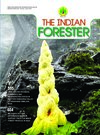Natural Regeneration in the Tropical Deciduous Forest Ecosystem of Godavari Valley in Warangal Region of Telangana, India
DOI:
https://doi.org/10.36808/if/2018/v144i7/130917Keywords:
Dry Deciduous Forest Vegetation, Regeneration, Godavari Watershed, Telangana, India.Abstract
The regeneration, recruitment and succession of tree species were studied in three vegetation zones of Godavari valley in Warangal region, Telangana. The regeneration ability of the individual forest species was observed zone-wise of mature individuals in proportion to the saplings and seedlings to predict the future vegetation of a tropical deciduous forest ecosystem. The study prospects the changes in the native species composition in forest zone-wise. The vegetation structure of Tectona- Terminalia zone will remain unchanged, if protected, as it was being distant to populace and proximate to river Godavari and also better protected being under Eturnagaram Wildlife Sanctuary. Within this vegetation zone, the threat to teak is imminent and it may be replaced by Cleistanthus collinus, a species of far less economic value. Madhuca- Terminalia-Haldina zone is with no saplings of prime species but for those of Terminalia. The absence of saplings and seedlings of Madhuca indica is due to harvesting of its seed for oil by the ethnic people. Terminalia- Hardwickia zone may also remain unchanged though Terminalia species show better regeneration. The ecological changes due to disturbance gradients have resulted in succession of different species other than those of the naturally occurring along the environmental gradients within the watershed.References
Anon. (1990). Watershed Atlas of India. Publishers: All India Soil and Land Use Survey. Ministry of Agriculture, Government of India, New Delhi.
Anon. (1999). Report of the STAP Brainstorming on Biodiversity Conservation in Production Forests. Mexico.
Barker P.C.J. and Patrick J.B.K. (1994). Phyllocladus asplenifolius: variability in the population structure of the regeneration niche and dispersion pattern in Tasmanian forest. Australian J. Bot., 42:163-190
Barnes B.V., Zak D.R., Denton S.R. and Spurr S.H. (1998). th Forest Ecology. 4 edn. Wiley, New York.
CBD (Convention on Biological Diversity) Secretariat (2001). Global Biodiversity Outlook. Montreal, Canada.
Cremer K.W. (1990). Trees for Rural Australia. Inkata Press, Melbourne.
Fleischner T.L. (1994). Ecological costs of livestock grazing in western North America. Conserv. Biol., 8:629-644
Gadgil M. and Meher-Homji V.M. (1983). Ecological Diversity. In: Conservation in Developing Countries Problems and Prospects (J.C. Daniel and S. Serrao, Eds.), Proc. Centonary Seminar of the Bombay Nat. Hist. Soc., Bombay, 175-198 pp.
Girma A. and Mosandl R. (2012). Structure and potential regeneration of degraded secondary stands in MunessaShashemene Forest, Ethiopia. J. Trop. For. Sci., 24:46-53.
Gopalkrishna P. (2000). Application of Geoinformatics in Vegetation – Ecosystem Analysis in part of Godavari Valley – Warangal, Andhra Pradesh. Ph.D. thesis, Kakatiya University, Warangal.
Herrera C.M., Jordano P., Lopez-Soria L. and Amat J.A. (1994). Recruitment of a mast-fruiting, bird-dispersed tree: bridging frugivore activity and seedling establishment. Ecol. Monogr., 64:315-344
Hutchinson G.E. (1965). The Ecological Theater and the Evolutionary Play. Yale University Press, Yale.
Jones R.H., Shanitz R.R., Dixon P.M., Segal D.S. and Schneides R.L. (1994). Wood plant regeneration in four flood plain forests. Ecol. Monogr., 64:345-367
Kelly D. and Sork V.L. (2002). Mast seeding in perennial plants: Why, how, where? Annu. Rev. Ecol. Syst., 33:427-447 Misra R. (1968). Ecology Work Book. Oxford & IBH Publishing Co, New Delhi.
Murthy I.K., Murali K.S., Hegde G.T., Bhat P.R. and Ravindranath N.H. (2002). A comparative analysis of regeneration in natural forest and joint forest management plantations in Uttar Kannada district, Western Ghats. Curr. Sci., 83:1358-1364
Platt S. (1992). Natural regeneration: principles and practice. LW0013. The State of Victoria, 1996-2008, pp. 1-8. http://www.lowecol.com.au/lfw/gfwmeminfo/Natural %20regeneration%20Principles%20and%20Practice.pdf]
Pokhriyal P., Uniyal P., Chauhan D.S. and Todaria N.P. (2010). Regeneration status of tree species in forest of Phakot and Pathri Rao watersheds in Garhwal Himalaya. Curr. Sci., 98:171-175
Raju V.S., Krishna P.G. and Suthari S. (2014). Environmental assessment of climate of a habitat through floristic lif-form spectra, a case study of Warangal north forest division, Telangana, India. J. Nat. Sci., 2(1):77-93
Saxena A.K. and Singh J.S. (1984). Tree population structure of certain Himalayan forest associations and implications concerning their future composition. Vegetatio, 58:61-69
Shankar U. (2001). A case study of high tree diversity in a sal (Shorea robusta) dominated lowland forest of Eastern Himalaya: Floristic composition, regeneration and conservation. Curr. Sci., 81:776-786
Singh J. (1985). Effects of habitat conditions on the regeneration of tree species at Idukki, Kerala. Environ. Ecol., 3:6-9 Suthari S., Kandagatla R., Geetha S., Ragan A. and Raju V.S.
(2016). Intrusion of devil weed Chromolaena odorata, an exotic invasive, into Kinnerasani and Eturnagaram wildlife sanctuaries, Telangana, India. J. Threat. Taxa, 8(2):8538-8540
Temple J.M. and Bungey D. (1980). Revegetation: Methods and Management. State Pollution Control Commission, New South Wales.
Tripathi R.S. and Khan M.L. (2007). Regeneration dynamics of natural forests-A review. Proc. Indian Nat. Sci. Acad., 73:167-195
Vandenberghe C., Francois F., Moravie M.A., Gadallah F. and Buttler A. (2007). Short-term effects of cattle browsing on tree sapling growth in mountain wooded pastures. Plant Ecol., 188:253-264
Downloads
Downloads
Published
How to Cite
Issue
Section
License
Unless otherwise stated, copyright or similar rights in all materials presented on the site, including graphical images, are owned by Indian Forester.





